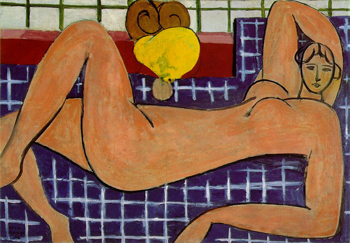| Search Art Prints | ||||||||||||||||||||
| Search Artists | ||||||||||||||||||||

|
||||||||||||||||||||
|
|
|||||||||||||||||||

Large Reclining Nudealso known as Pink Nude

|
Pink Nude is an important work in the transition to Matisse's later painting style and to his use of cut-outs. This work is the first in which the artist used cut paper to change and shape the image. Also for the first time, Matisse was photographed while working on this piece over a period of several months.
In the 1930s, Matisse became interested in simplifying, flattening and abstracting forms. He reduced the sense of viewpoint. Images became signs for what they represented. Matisse would begin by painting an image and then eliminate detail to create a smooth, flattened area. New emphasis was placed on bright colors and on the spaces between the represented objects.
Pink Nude began as a natural portrait of a reclining woman surrounded by a chair and a vase of flowers. Gradually, Matisse changed the structure of the image by flattening and abstracting the forms and creating a geometric pattern in the background. The woman's body is presented as a series of curves against the geometric grid; this is meant to suggest the extreme opposition between movement and stillness or passion and reason. In painting the vase the same bright pink as the woman's flesh, Matisse may have been suggesting a connection between the earthy, reproductive nature of woman and the vase which holds the growing flowers. The inverted, abstract chair appears as another symbol of fertility and procreation.
This work can be compared to Matisse's Blue Nude as the pink figure's pose is a variation on the earlier work. Pink Nude, however, maintains a more restrained and cooler air than the highly sensual subject of Blue Nude. This new restraint and abstraction marks an important shift in Matisse's work.











